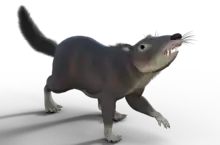Australosphenida
The Australosphenida are a proposed infraclass of mammals within subclass Yinotheria. Today, there are only five surviving species, which live in Australia and New Guinea, but fossils have been found in Madagascar and Argentina. The surviving species consist of the platypus and four species of echidna. Contrary to other known crown mammals, they retained postdentary bones as shown by the presence of a postdentary trough. The extant members (monotremes) developed the mammalian middle ear independently.
| Australosphenida | |
|---|---|
 | |
| Short-beaked echidna | |
| Scientific classification | |
| Kingdom: | Animalia |
| Phylum: | Chordata |
| Class: | Mammalia |
| Subclass: | Yinotheria |
| Infraclass: | Australosphenida Luo, Cifelli, & Kielan-Jaworowska, 2001 |
| Taxa | |
| |
Taxonomy
This grouping includes the following taxa:
- Monotremata, divided into the families Ornithorhynchidae (platypus), Steropodontidae and Tachyglossidae (echidnas) and the genus Kryoryctes
- †Henosferidae, including the genera Ambondro, Asfaltomylos, and Henosferus from the Jurassic of Argentina and Madagascar.
- †Ausktribosphenidae, including the genera Ausktribosphenos, Bishops from the Middle Jurassic to Lower Cretaceous of Australia.
- †Kollikodontidae, formerly included in true monotremes but now thought to form an outgroup.[1]
- †Vincelestes, sometimes recovered as an australosphenidan (when not inversely considered a cladotherian).[2][3]
- †Tendagurutherium, also recently recovered as an australosphenidan.[4]
The clade Australosphenida was proposed by Luo et al. (2001, 2002) and was initially left unranked, as the authors do not apply the Linnaean hierarchy. In Benton (2005), it is ranked as a 'superdivision', i.e. one or two levels below the infraclass.
Australosphenid teeth
The grouping embodies a hypothesis about the evolution of molar teeth in mammals. Living monotremes are toothless as adults, but the juvenile platypus, fossil monotremes and Ausktribosphenida all share a pattern of three molar cusps arranged in a triangle or V shape, which is known as the tribosphenic type of molar. Tribosphenic molars have long been held to characterize the subclass Theria (marsupials, placentals and their extinct relatives), while monotremes were thought to be related to fossil groups with a linear alignment of cusps: morganucodontids, docodonts, triconodonts and multituberculates, all of which were united with the monotremes into the 'subclass Prototheria'. Defined in this way, the 'Prototheria' is no longer recognised as a valid clade, since the linear cusp pattern is a primitive condition within Mammalia and cannot supply the shared derived character, which is required to establish a subgroup. Instead, the available evidence suggests that the monotremes descend from a Mesozoic radiation of tribosphenic mammals in the southern continents (hence the name Australosphenida, meaning 'southern wedges'), but this interpretation is highly controversial.
According to Luo et al., tribosphenic molars were evolved by the Australosphenida independently of the true Tribosphenida, or Boreosphenida (that is, the therians and their relatives) in the northern continents. Others contend that the Ausktribosphenida in fact belong to the placentals and were therefore true tribosphenids, but unrelated to the ancestry of the monotremes.[5] If this were confirmed, it would entail abandoning the clade Australosphenida.
Most recent phylogenetic studies validate this clade, lumping henosferids and aukstribosphenids alongside monotremes.[6][7]
Notes
- Rebecca Pian; Michael Archer; Suzanne J. Hand; Robin M.D. Beck; Andrew Cody (2016). "The upper dentition and relationships of the enigmatic Australian Cretaceous mammal Kollikodon ritchiei". Memoirs of Museum Victoria. 74: 97–105.
- Nicholas Chimento, Frederico Agnolin, Agustin Martinelli, Mesozoic Mammals from South America: Implications for understanding early mammalian faunas from Gondwana, May 2016
- José Bonaparte, On the phylogenetic relationships of Vincelestes neuquenianus, Published online: 17 Sep 2008
- Nicholas Chimento, Frederico Agnolin, Agustin Martinelli, Mesozoic Mammals from South America: Implications for understanding early mammalian faunas from Gondwana, May 2016
- Benton 2005: 300, 306-308.
- Richard Stephen Thompson, Rachel O'Meara, Were There Miocene Meridiolestidans? Assessing the Phylogenetic Placement of Necrolestes patagonensis and the Presence of a 40 Million Year Meridiolestidan Ghost Lineage, Article in Journal of Mammalian Evolution · September 2014 DOI: 10.1007/s10914-013-9252-3
- Rebecca Pian; Michael Archer; Suzanne J. Hand; Robin M.D. Beck; Andrew Cody (2016). "The upper dentition and relationships of the enigmatic Australian Cretaceous mammal Kollikodon ritchiei". Memoirs of Museum Victoria. 74: 97–105.
References
- Benton, Michael J. (2005). Vertebrate Palaeontology (3rd ed.). Oxford: Blackwell Publishing. ISBN 0-632-05637-1.
- Luo, Zhe-Xi; Cifelli, Richard L.; Kielan-Jaworowska, Zofia (2001). "Dual origin of tribosphenic mammals". Nature. 409: 53–57. doi:10.1038/35051023. PMID 11343108.
- Luo, Zhe-Xi; Kielan-Jaworowska, Zofia; Cifelli, Richard L. (2002). "In quest for a phylogeny of Mesozoic mammals" (PDF). Acta Palaeontologica Polonica. 47 (1): 1–78.





